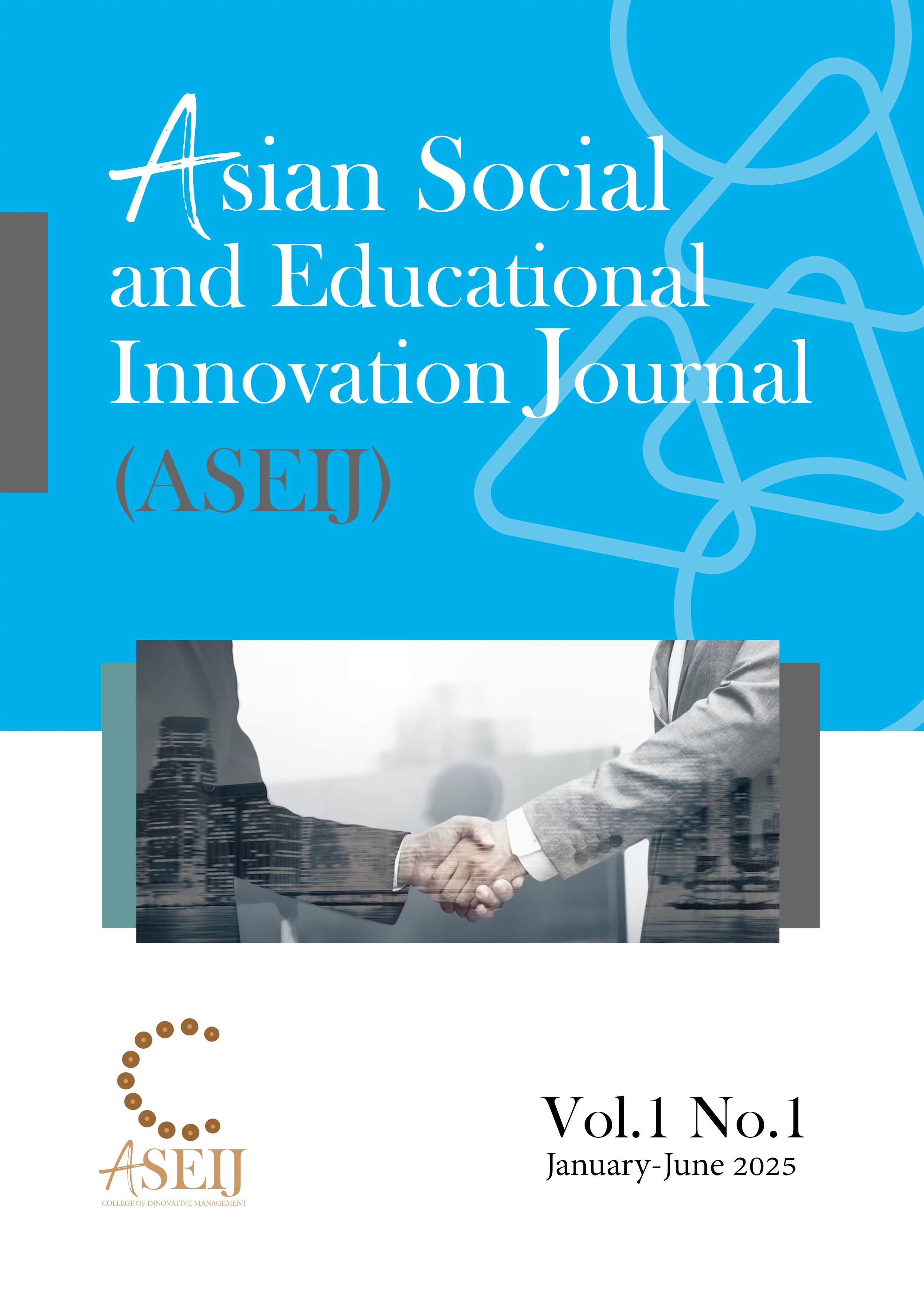The role of mediator variables in the relationship between service quality, brand identification and brand loyalty of boutique hotels in Bangkok
Main Article Content
Abstract
The purpose of this study was to investigate the mediating role of emotional commitment in the relationship between service quality, brand identification, and brand loyalty among Thai tourists who made boutique hotel bookings under the Rao Tiew Duay Kan co-payment scheme during the COVID-19 pandemic. The population and sample consisted of 260 Thai tourists who had made such bookings. The data was collected through purposive sampling and analyzed using the Partial Least Squares approach to Structural Equation Modeling (SEM) with IBM SPSS AMOS version 26 software. The data analysis included descriptive statistics, such as frequency, percentage, mean, and standard deviation, and inferential statistics, including the Ordinary Least Squares method and the bootstrapping technique in SEM. The results revealed that emotional commitment served as a mediator between service quality, brand identification, and brand loyalty among Thai tourists who made boutique hotel bookings under the Rao Tiew Duay Kan co-payment scheme during the COVID-19 pandemic.
Article Details

This work is licensed under a Creative Commons Attribution-NonCommercial-NoDerivatives 4.0 International License.
References
Lehtinen, U. and J.R. Lehtinen, Two approaches to service quality dimensions. Service Industries Journal, 1991. 11(3): p. 287–303.
Day, J., Quadri, D., Jones, D.L. and F. Kiradjian, Boutique and lifestyle hotels: Emerging definitions. BLLA, Boutique & Lifestyle Lodging Association, 2012.
Ashwell, M. and S. Gibson, Waist-to-height ratio as an indicator of ‘early health risk’: Simpler and more predictive than using a ‘matrix’ based on BMI and waist circumference. BMJ Open, 2016. 6(3): p. e010159.
Harris, L.C. and C. Ezeh, Servicescape and loyalty intentions: An empirical investigation. European Journal of Marketing, 2008. 42(3/4): p. 390–422.
Monferrer, T.D., Moliner, T.M.A. and G.M. Estrada, Ambidexterity as a key factor in banks’ perfor-mance: A marketing approach. Journal of Marketing Theory and Practice, 2019. 27(2): p. 227–250.
Sim, Mak and Jones, A model of customer satisfaction and retention for hotels. Journal of Quality Assurance in Hospitality & Tourism, 2006. 7(3): p. 1–23.
Al-Msallam, F., Customer satisfaction and brand loyalty in the hotel industry. International Journal of Management Sciences and Business Research, 2015. 4(9): p. 1–13.
Ghaderi, Z., Farashah, M.H.D.P., Aslani, E. and B. Hemati, Managers’ perceptions of the adaptive reuse of heritage buildings as boutique hotels: Insights from Iran. Journal of Heritage Tourism, 2020. 15(6): p. 696–708.
Altinay, L., Alrawadieh, Z., Tulucu, F. and H.E. Arici, The effect of hospitableness on positive emo-tions, experience, and well-being of hospital patients. International Journal of Hospitality Manage-ment, 2023. 110: p. 103431.
Casaló, L.V., Flavián, C. and S. Ibáñez-Sánchez, Be creative, my friend! Engaging users on Insta-gram by promoting positive emotions. Journal of Business Research, 2021. 130: p. 416–425.
Birgit, L.P., Mechanism connecting environmental friendliness to service loyalty: The role of positive customer emotions and satisfaction. Services Marketing Quarterly, 2019. 40(2): p. 157–171.
Parasuraman, A., Zeithaml, V. and L. Berry, SERVQUAL: A multiple-item scale for measuring con-sumer perceptions of service quality. Journal of Retailing, 1988. 64: p. 2–40.
Moorman, C., Zaltman, G. and R. Deshpande, Treating employees fairly and organizational citizen-ship behaviors: Sorting the effects of job satisfaction, organizational commitment, and procedural justice. Employee Responsibilities and Rights Journal, 1992. 6(3): p. 209–225.
Prakash, A. and R.P. Mohanty, A study of service quality in healthcare system using artificial neural networks. Vilakshan: The XIMB Journal of Management, 2012. 9(2).
Morgan, R.M. and S.D. Hunt, The commitment-trust theory of relationship marketing. Journal of Marketing, 1994. 58(3): p. 20–38.
Dwyer, F.R., Schurr, P.H. and S. Oh, Developing buyer-seller relationships. Journal of Marketing, 1987. 51(2): p. 11–27.
Thomson, M., MacInnis, D.J. and C.W. Park, The ties that bind: Measuring the strength of consum-ers’ emotional attachments to brands. Journal of Consumer Psychology, 2005. 15(1): p. 77–91.
Bhattacherjee, A., Understanding information systems continuance: An expectation-confirmation model. MIS Quarterly, 2001. 25(3): p. 351–370.
Baloglu, S., Zhong, Y.Y. and S. Tanford, Casino loyalty: The influence of loyalty program, switching costs, and trust. Journal of Hospitality & Tourism Research, 2017. 41(7): p. 846–868.
Mattila, A.S., The impact of affective commitment and hotel type in influencing guests' share of wal-let. Journal of Hospitality & Leisure Marketing, 2007. 15(4): p. 55–68.
Alkhawaldeh, A.M., Salleh, S.M. and F.B. Halim, Brand equity and brand loyalty: New perspective. International Review of Management and Marketing, 2016. 6(4): p. 722–730.
Buhagiar, K., Pace, L.A. and S.M. Dingli, Defining attributes of boutique hotels: A systematic litera-ture review. Journal of Hospitality and Tourism Insights, 2024. 7(1): p. 207–226.
Lim, W.M. and M. Endean, Elucidating the aesthetic and operational characteristics of UK boutique hotels. International Journal of Contemporary Hospitality Management, 2009. 21(1): p. 38–51.
Aggett, M., What has influenced growth in the UK's boutique hotel sector? International Journal of Contemporary Hospitality Management, 2007. 19(2): p. 169–177.
Hair, J.F., Sarstedt, M., Ringle, C.M. and J.A. Mena, An assessment of the use of partial least squares structural equation modeling in marketing research. Journal of the Academy of Marketing Science, 2012. 40: p. 414–433.
Meyer, J.P., Allen, N.J. and C.A. Smith, Commitment to organizations and occupations: Extension and test of a three-component conceptualization. Journal of Applied Psychology, 1993. 78(4): p. 538–551.
Mowday, R.T., Steers, R.M. and L.W. Porter, The measurement of organizational commitment. Journal of Vocational Behavior, 1979. 14(2): p. 224–247.


